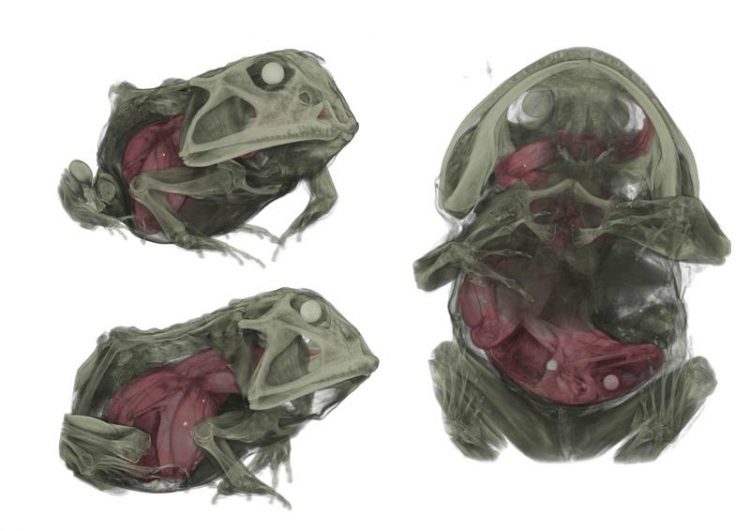A frog in the throat

A frog in the throat. Dr Thomas Kleinteich, Kiel University
“I work as a research associate on a project into the sticky characteristics of amphibian tongues”, says Dr Thomas Kleinteich, from the Functional Morphology and Biomechanics working group at the Zoological Institute at Kiel University.
He generates three-dimensional computer models of animals using a micro-CT scanner, which works in a similar way to a medical CT scanner but is designed for investigating small objects. Kleinteich: “To do so, I use museum specimens conserved in alcohol. In this case, it is a South-American horned frog Ceratophrys from the collection at the Zoological Museum in Hamburg.”
When analysing the scan, Kleinteich found that another animal was present inside the frog: “We have known for a while that horned frogs are able to eat very large prey.
Last year I was able to show experimentally, that horned frogs can produce extremely strong adhesive strength with their tongues, which they also need in order to catch larger prey. With the micro-CT I am able to show, for the first time, how such a large catch can even fit inside a horned frog.”
The image of the frog with a frog in its throat won a competition in May from the CT-manufacturing company “Bruker microCT”.
Original publication:
Kleinteich, Thomas: “To have a frog in the throat: micro-CT imaging of anuran prey in Ceratophrys ornata (Anura: Ceratophryidae)”, in: SALAMANDRA – German Journal of Herpetology, Volume 51, No. 2, June 30th 2015.
Previous press releases on Dr Kleinteich's research:
www.uni-kiel.de/pressemeldungen/index.php?pmid=2014-172-froschzungen
www.uni-kiel.de/pressemeldungen/index.php?pmid=2014-021-klebezungen
www.uni-kiel.de/pressemeldungen/index.php?pmid=2013-270-teufelsrochen
Contact:
Dr Thomas Kleinteich
Spezielle Zoologie – Functional Morphology and Biomechanics
Tel.: +49 (0) 431 / 880 – 4509
E-Mail: tkleinteich@zoologie.uni-kiel.de
http://www.uni-kiel.de/pressemeldungen/index.php?pmid=2015-202-frosch-im-frosch&…
Media Contact
All latest news from the category: Life Sciences and Chemistry
Articles and reports from the Life Sciences and chemistry area deal with applied and basic research into modern biology, chemistry and human medicine.
Valuable information can be found on a range of life sciences fields including bacteriology, biochemistry, bionics, bioinformatics, biophysics, biotechnology, genetics, geobotany, human biology, marine biology, microbiology, molecular biology, cellular biology, zoology, bioinorganic chemistry, microchemistry and environmental chemistry.
Newest articles

A ‘language’ for ML models to predict nanopore properties
A large number of 2D materials like graphene can have nanopores – small holes formed by missing atoms through which foreign substances can pass. The properties of these nanopores dictate many…

Clinically validated, wearable ultrasound patch
… for continuous blood pressure monitoring. A team of researchers at the University of California San Diego has developed a new and improved wearable ultrasound patch for continuous and noninvasive…

A new puzzle piece for string theory research
Dr. Ksenia Fedosova from the Cluster of Excellence Mathematics Münster, along with an international research team, has proven a conjecture in string theory that physicists had proposed regarding certain equations….



